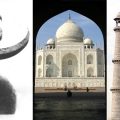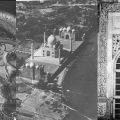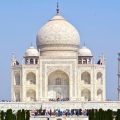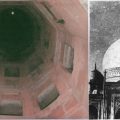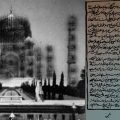33 Points that Prove Shah Jahan Did Not Build the Taj Mahal
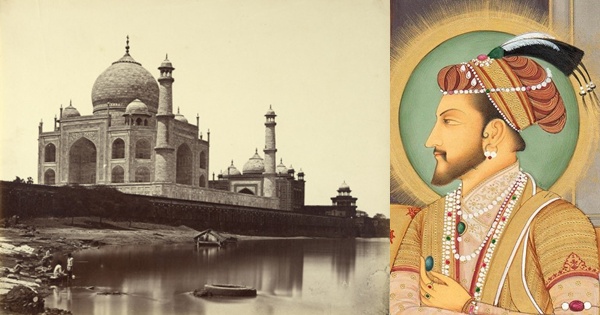
The Mughals, during their rule, looted and destroyed hundreds of thousands of Hindu temples. Do you know Aurangzeb himself destroyed 10,000 Hindu temples during his reign? Some of the larger temples were converted into mosques or other Islamic structures.
The most evident of such structures is the Taj Mahal, a structure supposedly devoted to love by the ‘great’ Mughal king Shah Jahan to his favorite wife Mumtaz Mahal. Do you know Shah Jahan had a harem of 5,000 women? Is such a person even capable of imagining such a wondrous structure as the Taj Mahal let alone be the architect of it?
Here are 33 points that prove Shah Jahan did not build the Taj Mahal.
1. The Taj Mahal precincts extend to several hundred yards in all directions. Across the river are ruins of the annexes of the Taj, the bathing ghats and a jetty for the ferry boat. In the Victoria gardens outside covered with creepers is the long spur of the ancient outer wall ending in a octagonal red stone tower. Such extensive grounds all magnificently done up, are a superfluity for a grave.
2. Had the Taj been specially built to bury Mumtaz, it should not have been cluttered with other graves. But the Taj premises contain several graves at least in its eastern and southern pavilions.
3. In the southern flank, on the other side of the Tajganj gate are buried in identical pavilions queens Sarhandi Begum, and Fatehpuri Begum and a maid Satunnisa Khanum. Such parity burial can be justified only if the queens had been demoted or the maid promoted. But since Shah Jahan had commandeered (not built) the Taj, he reduced it general to a Muslim cemetery as was the habit of all his Islamic predecessors, and buried a queen in a vacant pavilion and a maid in another identical pavilion.
4. Shah Jahan was married to several other women before and after Mumtaz. She, therefore, deserved no special consideration in having a wonder mausoleum built for her.
5. At the backside of the river bank is a Hindu crematorium, several palaces, Shiva temples and bathings of ancient origin. Had Shah Jahan built the Taj Mahal, he would have destroyed these Hindu features.
6. Mumtaz died in Burhanpur which is about 600 miles from Agra. Her grave there is intact. Therefore, the cenotaphs raised in stories of the Taj in her name seem to be fakes hiding in Hindu Shiva emblems.
7. Shah Jahan seems to have simulated Mumtaz’s burial in Agra to find a pretext to surround the temple palace with his fierce and fanatic troops and remove all the costly fixtures in his treasury. This finds confirmation in the vague noting in the Badshahnama which says that the Mumtaz’s (exhumed) body was brought to Agra from Burhanpur and buried `next year’. An official term would not use a nebulous term unless it is to hide some thing.
8. A pertinent consideration is that a Shah Jahan who did not build any palaces for Mumtaz while she was alive, would not build a fabulous mausoleum for a corpse which was no longer kicking or clicking.
9. Another factor is that Mumtaz died within two or three years of Shah Jahan becoming an emperor. Could he amass so much superfluous wealth in that short span as to squander it on a wonder mausoleum?
10. While Shah Jahan’s special attachment to Mumtaz is nowhere recorded in history his amorous affairs with many other ladies from maids to mannequins including his own daughter Jahanara, find special attention in accounts of Shah Jahan’s reign. Would Shah Jahan shower his hard earned wealth on Mumtaz’s corpse?
11. Shah Jahan was a stingy, usurious monarch. He came to throne murdering all his rivals. He was not therefore, the doting spendthrift that he is made out to be.
12. A Shah Jahan disconsolate on Mumtaz’s death is suddenly credited with a resolve to build the Taj. This is a psychological incongruity. Grief is a disabling, incapacitating emotion.
13. A infatuated Shah Jahan is supposed to have raised the Taj over the dead Mumtaz, but carnal, physical sexual love is again a incapacitating emotion. A womaniser is ipso facto incapable of any constructive activity. When carnal love becomes uncontrollable the person either murders somebody or commits suicide. He cannot raise a Taj Mahal. A building like the Taj invariably originates in an ennobling emotion like devotion to God, to one’s mother and mother country or power and glory.
14. Early in the year 1973, chance digging in the garden in front of the Taj revealed another set of fountains about six feet below the present fountains. This proved two things. Firstly, the subterranean fountains were there before Shah Jahan laid the surface fountains. And secondly those fountains aligned to the Taj are of pre Shah Jahan origin. Apparently the garden and its fountains had sunk from annual monsoon flooding and lack of maintenance for centuries during the Islamic rule.
15. The stately rooms on the upper floor of the Taj Mahal have been striped of their marble mosaic by Shah Jahan to obtain matching marble for raising fake tomb stones inside the Taj premises at several places. Contrasting with the rich finished marble ground floor rooms the striping of the marble mosaic covering the lower half of the walls and flooring of the upper storey have given those rooms a naked, robbed look. Since no visitors are allowed entry to the upper storey this despoliation by Shah Jahan has remained a well guarded secret. There is no reason why Shah Jahan’s loot of the upper floor marble should continue to be hidden from the public even after 200 years of termination of Moghul rule.
16. Bernier, the French traveller has recorded that no non-Muslim was allowed entry into the secret nether chambers of the Taj because there are some dazzling fixtures there. Had those been installed by Shah Jahan they should have been shown the public as a matter of pride. But since it was commandeered Hindu wealth which Shah Jahan wanted to remove to his treasury, he didn’t want the public to know about it.
17. The approach to Taj is dotted with hillocks raised with earth dug out from foundation trenches. The hillocks served as outer defences of the Taj building complex. Raising such hillocks from foundation earth, is a common Hindu device of hoary origin. Nearby Bharatpur provides a graphic parallel. Peter Mundy has recorded that Shah Jahan employed thousands of labourers to level some of those hillocks. This is a graphic proof of the Taj Mahal existing before Shah Jahan.
18. Mumtaz was a commoner by birth and so she did not qualify for a fairyland burial.
19. The story that Shah Jahan wanted to build a black marble Taj across the river, is another motivated myth. The ruins dotting the other side of the river are those of Hindu structures demolished during Muslim invasions and not the plinth of another Taj Mahal. Shah Jahan who did not even build the white Taj Mahal would hardly ever think of building a black marble Taj! He was so miserly that he forced labourers to work gratis even in the superficial tampering necessary to make a Hindu temple serve as a Muslim tomb.
20. The marble that Shah Jahan used for grafting Koranic lettering in the Taj is of a pale white shade while the rest of the Taj is built of a marble with rich yellow tint. This disparity is proof of the Koranic extracts being a superimposition.
21. Though imaginative attempts have been made by some historians to foist some fictitious name on history as the designer of the Taj, others more imaginative have credited Shah Jahan himself with superb architectural proficiency and artistic talent which could easily conceive and plan the Taj even in acute bereavement. Such people betray gross ignorance of history in as much as Shah Jahan was a cruel tyrant, a great womaniser and a drug and drink addict.
22. Fanciful accounts about Shah Jahan commissioning the Taj are all confusing. Some asserted that Shah Jahan ordered building drawing from all over the world and chose one from among them. Others assert that a man at hand was ordered to design a mausoleum and his design was approved. Had any of those versions been true Shah Jahan’s court papers should have had thousands of drawings concerning the Taj. But there is not even a single drawing. This is yet another clinching proof that Shah Jahan did not commission the Taj.
23. The Taj Mahal is surrounded by huge mansions which indicate that several battles have been waged around the Taj several times.
24. At the south east corner of the Taj is an ancient royal cattle house. Cows attached to the Tejo Mahalay temple used to reared there. A cowshed is an incongruity in an Islamic tomb.
25. Over the western flank of the Taj are several stately red stone annexes. These are superfluous for a mausoleum.
26. The entire Taj complex comprises of 400 to 500 rooms. Residential accommodation on such a stupendous scale is unthinkable in a mausoleum.
27. The neighbouring Tajganj township’s massive protective wall also encloses the Taj Mahal temple palace complex. This is a clear indication that the Tejo Mahalay temple palace was part and parcel of the township. A street of that township leads straight into the Taj Mahal. The Tajganj gate is aligned in a perfect straight line to the octagonal red stone garden gate and the stately entrance arch of the Taj Mahal. The Tajganj gate besides being central to the Taj temple complex, is also put on a pedestal. The western gate by which the visitors enter the Taj complex is a comparatively minor gateway. It has become the entry gate for most visitors today because the railway station and the bus station are on that side.
28. The Taj Mahal has pleasure pavilions which a tomb would never have.
29. A tiny mirror glass in a gallery of the Red Fort in Agra reflects the Taj Mahal. Shah Jahan is said to have spent his last eight years of life as a prisoner in that gallery peering at the reflected Taj Mahal and sighing in the name of Mumtaz. This myth is a blend of many falsehoods. Firstly, old Shah Jahan was held prisoner by his son Aurangzeb in the basement storey in the Fort and not in an open, fashionable upper storey. Secondly, the glass piece was fixed in the 1930’s by Insha Allah Khan, a peon of the archaeology dept just to illustrate to the visitors how in ancient times the entire apartment used to scintillate with tiny mirror pieces reflecting the Tejo Mahalay temple a thousand fold. Thirdly, a old decrepit Shah Jahan with pain in his joints and cataract in his eyes, would not spend his day craning his neck at an awkward angle to peer into a tiny glass piece with bedimmed eyesight when he could as well his face around and have full, direct view of the Taj Mahal itself. But the general public is so gullible as to gulp all such prattle of wily, unscrupulous guides.
30. That the Taj Mahal dome has hundreds of iron rings sticking out of its exterior is a feature rarely noticed. These are made to hold Hindu earthen oil lamps for temple illumination.
31. Those putting implicit faith in Shah Jahan authorship of the Taj have been imagining Shah Jahan-Mumtaz to be a soft hearted romantic pair like Romeo and Juliet. But contemporary accounts speak of Shah Jahan as a hard-hearted ruler who was constantly egged on to acts of tyranny and cruelty, by Mumtaz.
32. School and College history carry the myth that Shah Jahan’s reign was a golden period in which there was peace and plenty and that Shah Jahan commissioned many buildings and patronized literature. This is pure fabrication. Shah Jahan did not commission even a single building as we have illustrated by a detailed analysis of the Taj Mahal legend. Shah Jahan had to enrage in 48 military campaigns during a reign of nearly 30 years which proves that his was not a era of peace and plenty.
33. The interior of the dome rising over Mumtaz’s cenotaph has a representation of sun and cobras drawn in gold. Hindu warriors trace their origin to the sun. For an Islamic mausoleum the sun is redundant. Cobras are always associated with Lord Shiva.
Source Ref (most text put as they are):
1. Tajmahal The True Story authored by Shri P.N. Oak (A. Ghosh Publisher, 5720 W. Little York # 216, Houston, Texas 77091).
2. Badshahnama:Abdul Hamid Lahori (Urdu: عبدالحمید لاہوری ; died 1654) was a traveller and historian during the period of Shah Jahan who later became a court historian of Shah Jahan. He wrote the book Badshahnama also referred as Badshahnama
Visit Indian History Real Truth Facebook group to view related posts. This article is part of ‘JEWELS OF BHARATAM SERIES [TM]‘ by the author.
Disclaimer: The views expressed here are solely of the author. My India My Glory does not assume any responsibility for the validity or information shared in this article by the author.
Featured image courtesy: Pinterest.
Related post: Nalanda: 9 Million Books Burnt in 1193 by Bakhtiyar Khilji.

